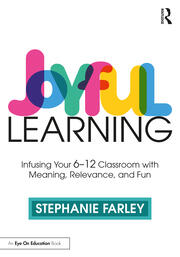Teaching Stunts Offer Choice, Challenge, Play
By Stephanie Farley

You guys, you’ll never believe what happened! Last night, I was chopping cucumbers in my kitchen and caught movement in my peripheral vision. At the exact same time, the temperature in the room dropped 20 degrees.
When I turned my head to look for the source of the movement, I saw, standing in front of the window, a, like, translucent man. His hair was a mixture of grey and white, his grey skin sported a few days’ worth of grey whiskers, and he wore a pine green cardigan over a tan button-down shirt and dad jeans. I don’t remember his shoes.
While he didn’t look like my grandpa, he gave off strong grandpa vibes in his calm yet inquisitive bearing. His appearance startled me, of course, and I jumped back and softly yelled, like “aaaahhhhh.”
When I settled enough to really stare at him, I realized he was made of some kind of mist. I could see the molecules moving around like droplets of water in the sunshine. Stepping back, I raised my hands in a “I surrender” posture and whispered, “where did you come from?” But as I spoke, he vanished. The molecules just disappeared and he was gone. My dog slept through the whole thing. What do you think that was about?
I told this particular story in the first few moments of an 8th grade English class. It took up maybe one minute of time. But by the time the story ended, I had everyone’s attention and almost everyone had a question about what I’d relayed.
Some students thought the apparition was a ghost while others thought the creature was a time traveler or holographic projection, like the Princess Leia message R2D2 shared in the first Star Wars movie.
The kids wrote about how they might investigate the phenomenon I “experienced” and what its appearance could mean. Eventually, students made observations in their own homes, wrote notes about what they observed, and used those notes for the basis of an adventure/mystery story.
A “stunt” unit full of remarkable learning
This unit took about 8 weeks from start to finish, and during that time the kids learned about unreliable narrators, starting a story in the middle of the action, pacing, foreshadowing, story frames, and characters.
They also deepened their understanding of big ideas, descriptive language, voice, and writing conventions. All around, the project was a win: students had choice, they developed their suspense skills, and the work itself held their interest. I call this particular flavor of instruction stunt teaching.
The why and how of stunt teaching
Stunt teaching is, most simply, a focus on engaging students through the element of novelty or surprise, then maintaining engagement with the qualities of choice, challenge, and play.
Typically, I structure stunts at the beginning of a unit, as in the example above. For a stunt to be worthwhile, it needs to serve a narrative and/or illustrative purpose. In other words, the stunt should introduce the topic and, when possible, act as an exemplar of what the students will attempt to create in their own work.
The best stunts also have a significant impact on comprehension of unit concepts. In my apparition story, for example, the concept of the unreliable narrator comes into focus, as students increasingly recognize the possibilities of storytelling that emerge if the teller/protagonist is a touch untrustworthy.
Other stunts I’ve staged help students apprehend slippery notions like equivocation, courage, and revolution. Nothing brings home the concept of revolution like an English teacher asking a classroom of 8th graders to complete 100 jumping jacks or toe touches!
Lastly, stunts should reflect student interests. The year I introduced “adventure writing” with the Ghost Grandpa – my students were into the supernatural.
With a little help from my friends…
The stunts can be super simple or more elaborate, like staging a crime scene and planting evidence throughout the school so students can solve a mystery before writing one of their own. Here are few other favorites:

Once my teacher confederates are gone, I turn to the class and say, “Wow, what just happened? Let’s write about it!” The argument transforms into a lesson about perspective, how mysteries develop, or how actions reveal character.
►I invite a person to the classroom that the kids may have seen around, but don’t know well, like a high school teacher. The guest strolls around the classroom and occasionally poses while students observe and write a description of the guest.
I ask students to record as many details as possible, attempting not to describe just how the person looks (hair color, clothing, etc.), but to detail an aspect of that person’s essence. What feelings does the person elicit? What is their aura? How would you characterize them?
Once the guest leaves, the students write a full character description, then a story featuring the character they’ve created. I share the completed stories with the guest. This is a novel, engaging way to train observation, build descriptive writing skills, and explore where stories come from.
Beyond the ELA classroom
Obviously the methods I’m sharing are those of an English teacher, but stunt teaching can be adapted for any subject! Wouldn’t it be enlightening to have a disagreement between Newton and Einstein prior to a physics lesson? Or to have students walk into a room with a giant tape triangle on the floor so they can lie down and be the hypotenuse? Play isn’t just for elementary recess: it helps students learn and thrive at all ages.
I mentioned above that in stunt teaching, engagement is maintained throughout a unit by incorporating choice, challenge, and play. The choice, of course, comes from all the decisions students make about how they’ll demonstrate mastery of learning targets.
In terms of challenge, I encourage students to tackle projects at a level that is in their zone of proximal development. If, for example, a student doesn’t want to write about the guest I’ve brought to class, they can write about any person/animal/object they like. Alternatively, if a student wants to try flashbacks and flash forwards to spice up their storytelling, I help them manage the timeline.
Finally, play means that even after the opening stunt, I’ll continue to incorporate silliness and levity into our work.
And I get to play too…
And here’s the real beauty of stunt teaching: it makes me want to get up and go to work, as I cannot wait to see the looks on student faces when I reveal my latest stunt. Each unit or lesson becomes an opportunity to exercise my creativity and humor and to feel connected, not just to my students but to the larger school community I’ve invited to be a part of the process.
Please give it a try and let me know how it goes! Or send me your ideas and I’ll troubleshoot them with you. Stunt teaching™ is suitable for all ages.

Stephanie’s first book is Joyful Learning: Tools to Infuse Your 6-12 Classroom with Meaning, Relevance, and Fun (Routledge/Eye On Education, 2023). She has created professional development for schools around reading and curriculum and coaches teachers in instruction, lesson planning, feedback, and assessment. Visit her website Joyful Learning and find her other MiddleWeb articles here.





































